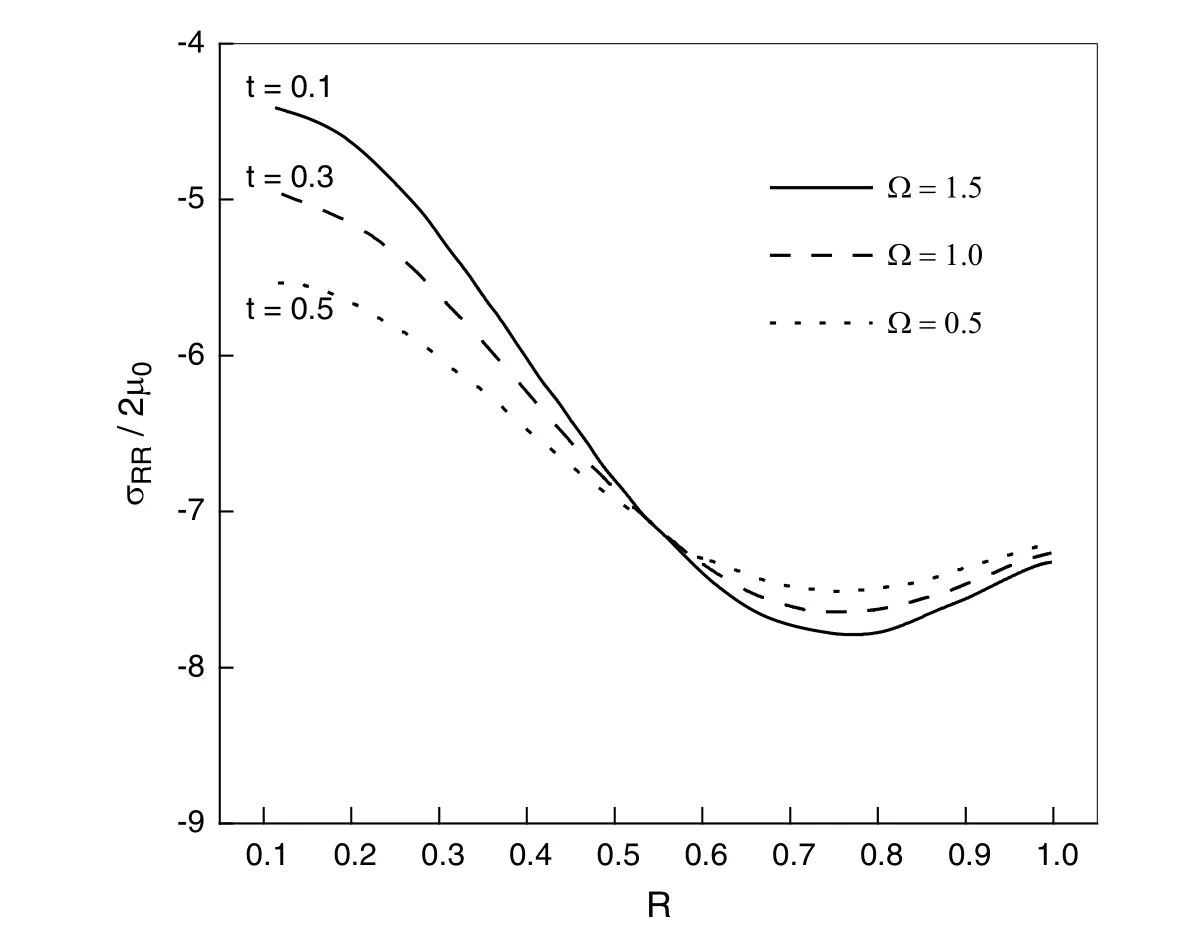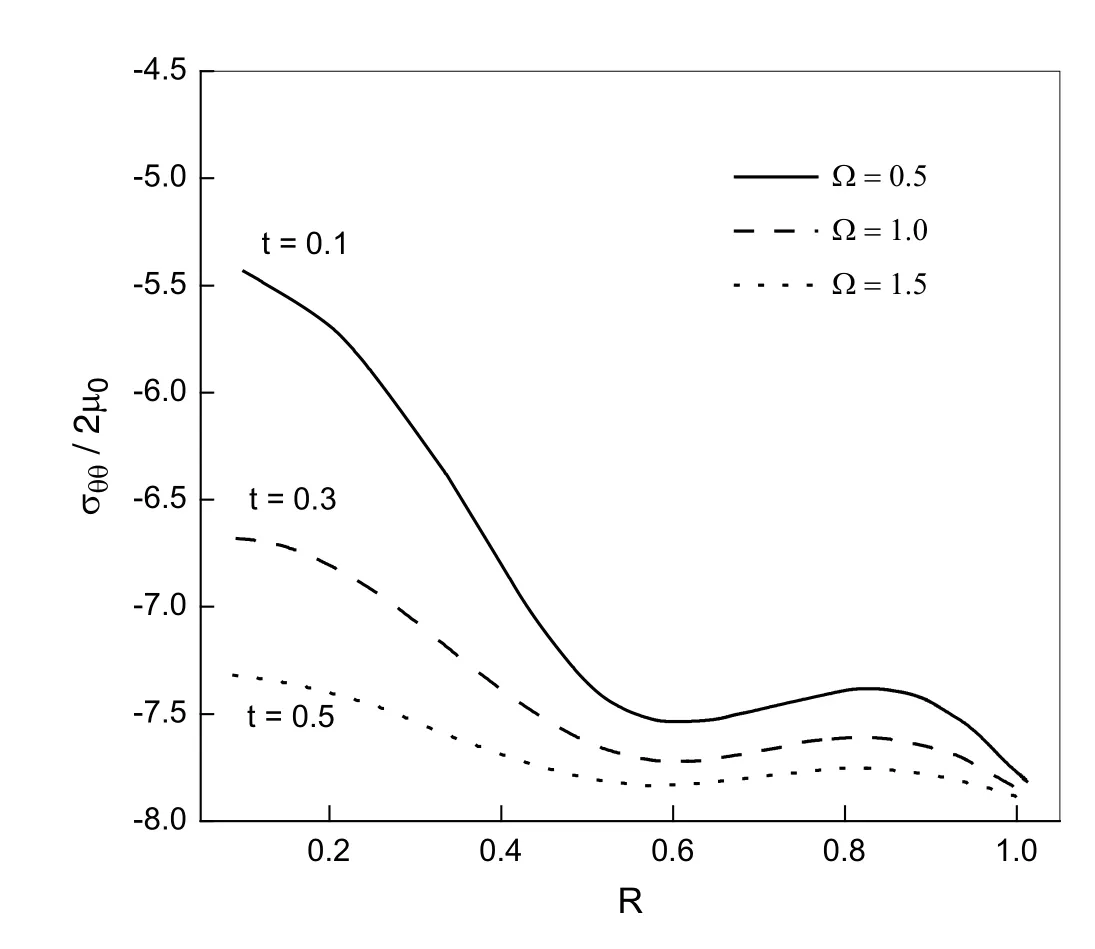Numerical Solution of a Problem of Thermal Stresses of a Magnetothermoelastic Cylinder with Rotation by Finite-Difference Method
2021-12-14BayonesAbdAllaandFarhan
F.S.Bayones,A.M.Abd-Alla and A.M.Farhan
1Department of Mathematics and Statistics,College of Science,Taif University,Taif,21944,Saudi Arabia
2Department of Mathematics,Faculty of Science,Sohag University,Egypt
3Physics Department,Faculty of Science,Jazan University,Jazan,Saudi Arabia
4Physics Department,Faculty of Science,Zagazig University,Zagazig,Egypt
Abstract:The present article deals with the investigation thermal stress of a magnetothermoelastic cylinder subjected to rotation,open or closed circuit,thermal and mechanical boundary conditions.The outer and inner surfaces of the cylinder are subjected to both mechanical and thermal boundary conditions.A The transient coupled thermoelasticity in an infinite cylinder with its base abruptly exposed to a heat flux of a decaying exponential function of time is devised solve by the finite-difference method.The fundamental equations’system is solved by utilizing an implicit finite-difference method.This current method is a second-order accurate in time and space;it is also unconditionally stable.To illustrate the present model’s efficiency,we consider a suitable material and acquire the numerical solution of temperature,displacement components,and the components of stresses with time t and through the radial of an infinite cylinder.The results indicate that the effect of coupled thermoelasticity,magnetic field,and rotation on the temperature,stresses,and displacement is quite pronounced.In order to illustrate and verify the analytical developments,the numerical solution of partial differential equations,stress components,displacement components and temperature is carried out and computer simulated results are presented graphically.This study is helpful in the development of piezoelectric devices.
Keywords:Thermoelasticity;thermal stress;finite-difference method;non-homogeneous material;rotation;magnetic field
1 Introduction
Thermoelasticity’s dynamic problem has received quite the attention in literature through the past decade.Recently,numerous thermoelastic structures interact among strain and temperature harnessed the attention of many researchers due to extensive uses in diving-related fields,i.e.,geophysics for to better understand Earth’s magnetic field effect on seismic waves,acoustic waves being dampened in magnetic fields,electromagnetic radiation emissions from nuclear devices,development of highly sensitive superconducting magnetometer,optics,electrical power engineering,etc.Bagri et al.[1]studied the unified generalized thermoelasticity,offering a solution for spheres and cylinders.Aziz et al.[2]gave further foundation to various concepts and applications of thermal stresses in a hollow cylinder subjected to convective boundary conditions.Propagation of Rayleigh waves in an elastic medum of orthotropic body was discussed by Abd-Alla [3].Cherechukin et al.[4]analyzed the shape memory effect due to magnetic field-induced thermoelastic martensitic transformation in a polycrystalline.The problem of the rotational effect on the propagation of surface waves in magneto-thermoelastic materials with voids was discussed by Farhan et al.[5].Ding et al.[6]Found the solution of the inhomogeneity orthotropic cylindrical shell for an axisymmetric plane strain.Abd-Elaziz et al.[7]discovered the effect of the Thomson parameter and inclined loads in an electro-magneto-thermoelastic solid with voids.Bayones et al.[8]discussed the eigenvalue approaches to coupled magneto-thermoelasticity structures in a rotating isotropic material.Bayones et al.[9]presented an analytical method for obtaining the wave propagation of a thermoelastic in a medium of a homogeneous isotropic material with effect of rotation and initial stress.Sheriff et al.[10]investigated propagation characteristics of discontinuities in electro-magneto generalized thermoelasticity in a cylindrical region.Abd-Elsalam et al.[11]found the numerical solution of the magneto-thermoelastic medium in an inhomogeneity isotropic cylinder via the finite-difference model.Othman et al.[12]considered the effect of magnetic field on a piezothermoelastic half-space with three theories.Othman et al.[13]studied the magnetic field,gravity field and rotation effects on a fiber-reinforced thermoelastic under three theories.Higuchi et al.[14]established the magneto-thermoelastic stresses induced by a magnetic field in a conducting solid cylinder.Abo-Dahab et al.[15]considered the effect of thermal stresses and magnetic fields in a thermoelastic medium without energy dissipation.Khader et al.[16]studied the uniform laser pulse for a solid cylinder via utilizing various theories of magnetothermoelasticity.Said [17]investigated the influence of mechanical load on a magneto-micropolar thermoelastic half-space.Said et al.[18]studied the two-temperature rotating-micropolar thermoelastic medium while being affected by a magnetic field.Mukhopadhyay et al.[19]found the solution to the problem of generalized thermoelasticity of a cylinder with inhomogeneity material characteristics a finite-difference model.Wang et al.[20]investigated the magneto-mechanical stress and change of magnetic field vectors in an inhomogeneity thermoelastic cylinder.Ahire et al.[21]considered the behavior of thermoelastic a thin and a hollow cylinder using an internal moving heat source.From the extensive literature on the topic,we can mention some interesting investigations in [22-32].
The present paper aims to study the behaviors of thermal stresses.Another attempt is made to describe certain physical properties theoretically and graphically.This paper focuses on the thermal stresses in an inhomogeneity generalized thermoelastic cylinder under a magnetic field.The magnetic field plays a big role in studying the thermal stresses in an isotropic medium.The problem is treated in the finite-difference model of the governing equations of thermal stresses of a magnetothermoelastic cylinder are transformed into a system of differential equations and the numerical solution for the field variables inside the cylinder for Cobalt material are obtained directly in the space-time domain.The variations of temperature,displacement,and stresses we reacquired numerically and analyzed graphically.
2 Formulations of the Problem
Let us consider a cylindrical coordinate system (r,θ,z),with thez-axis coinciding with the cylinder’s axis.To consider the strains’symmetry about the z-axis,we have only the radial displacementur=u,uθ=0,uz=0,which are independent of θ and z.
The Maxwell equations [20]

The heat conduction equation is

And the equation of motion is

where

The nonzero stress components are

whereσrrandσθθare the mechanical stress,is the mechanical displacement vector,ρis the density,c11,c12,c22are elastic constants,T′is the temperature,Ωis the uniform angular velocity,T0is the reference temperature solid,kis the thermal conductivity of the material,andγ=(β11+2β12).We define the quantities,c11,c12,c22andρof the inhomogeneous body by

whereβ11,β12,β22,ρ0,andμ0are constants (valuesc11,c12c22,ρandμeare inhomogeneous matter).Upon introducing the Eq.(6) in the Eq.(5),we obtain

Now using Eq.(7) in the Eq.(3),we get

The following non-dimensional scheme is a convenience to be considered:

whereT0is a reference temperature,vis the dimension of velocity.Introduced Eq.(9) in Eq.(2)and (8),we have:

Stress-displacement and temperature relations in the non-dimensional variables are given as

where

3 Boundary Conditions
The initial conditions as follows:

For the cylindrical problem,the boundary conditions as follows:

4 Solution of the Problem
The governing equations obtained in the last section are partial differential equations that will be solved by an implicit finite-difference method described by Mukhopadhyay et al.[18].The solution domaina≤R≤b,0≤t≤τis replaced by a grid illustrated by the node points(Ri,tn),in whichRi=1+ih,i=0,1,2,...,Nandtn=nk,n=0,1,2,...,K.Therefore,h=is taken as a mesh width and Δt=is assumed to be the time step.We use the notationuniinstead ofu(Ri,tn).
The functions T(R,t) and U(R,t) may be at any nodal location:

By Applying an implicit finite-difference technique,finite-difference equations corresponding to Eqs.(10) and (11) are as follows:

whereUni,Tniis the approximateU(1+ih,nΔt)andT(1+ih,nΔt),respectively,and

The finite-difference form of the initial conditions (14) and (15) are

The finite-difference form of the boundary conditions (16) and (17) are

5 Numerical Results and Discussion
The material chosen for the purpose of numerical calculation is Cobalt material,which is isotropic material.The physical data for Cobalt material is given [6]
T0=2000°C,M=2,τ=0.02,β11=17.075GPa,β22=6.757GPa,β12=7.289GPa,
k=1.14cal/s2,ρ0=8.93g/cm3.
Results are presented fora=0.1 andb=1.The variations are shown in Figs.1-10,respectively.
We assessed the non-homogeneous scenario by considering thatm=0.5.We illustrated the numerical outcomes via graphs.
Fig.1 demonstrates temperatureTvariation for various timestin the non-homogeneous case(m=0.5),temperature diminishes along side the surgingRin all three modes,fulfilling the boundary conditions for the cylinder problem.

Figure 1:Variations of temperature with distance 0≤R≤1 for varying values of time t at m=0.5,Ω=0.5,H0=0.5
Fig.2 demonstrates radial displacementUcompared toRdifferent values of magnetic fieldH0and timetin the non-homogeneous case(m=0.5);displacement diminishes with surgingRand it accumulates with increasingt.

Figure 2:Variations of radial displacement with distance 0≤R≤1 for varying values of the magnetic field and time at m=0.5,Ω=0.5...H0=.2×102,___H0=0.5×102,—-H0=.8×102
Fig.3 illustrates the variations of the radial stressσRRaccording toRacross various values of timetand the magnetic field in the non-homogeneous case(m=0.5);radial stress surges with the increase of magnetic field in the range 0.1≤R≤0.5,while it diminishes with the increase of time.Also,it decreases with the increase of the magnetic field in the interval 0.5≤R≤1,while it surges with the increase of time in the same interval,increasing with the increase ofR-the axis with the increase of timet.

Figure 3:Variations of radial stress with distance 0≤R≤1 for varying values of the magnetic field and time at m=0.5,Ω=0.5,...,H0=.2×102,___H0=.5×102,—-H0=.8×102
Fig.4 demonstrates tangential stressσθθvariations according toRacross various values of magnetic field and timetin the non-homogeneous case(m=0.5);radial stress surges with the increase of magnetic field in the interval 0.1≤R≤0.9 while it diminishes with the increase of time and surges with the increase ofR-the axis.

Figure 4:Variations of tangential stress with distance 0≤R≤1 for varying values of the magnetic field and time at m=0.5,Ω=0.5...H0=.2×102,___H0=.5×102,—-H0=.8×102
Fig.5 represents radial displacement variations according toRacross various values of magnetic field and timetin the homogeneous case(m=0).It is observed that the radial displacement increases with the increase of the magnetic field,while it decreases with the increase of time and it decreases and increases with the increase ofR-the axis.

Figure 5:Variations of radial displacement with distance 0≤R≤1 for varying values of the magnetic field and time at m=0,Ω=0.5...H0=.2×102,___H0=.5×102,—-H0=.8×102
Figs.6 and 7 represent radial displacement variations according toRacross various values of magnetic field and timetin the homogeneous case(m=0);radial stress surges with the increase of the magnetic field while it diminishes with the increase of time.

Figure 6:Variations of radial stress with distance 0≤R≤1 for varying values of the magnetic field and time at m=0,Ω=0.5...H0=.2×102,___H0=.5×102,—-H0=0.8×102

Figure 7:Variations of tangential stress with distance 0≤R≤1 for varying values of the magnetic field and time at m=0,Ω=0.5,...,H0=.2×102,___H0=.5×102,H0=.8×102
Fig.8 illustrates radial displacement variations according toRacross various values of rotationΩand timetin the non-homogeneous casem=0.5;radial displacement surges with the increase of rotation and time while it increases and decreases with the increase ofR-axis.

Figure 8:Variations of radial displacement with distance 0≤R≤1 for varying values of rotation Ω and time t at m=0.5,H0=.2×102
Fig.9 exhibits radial stress variations according toRfor various values of rotationΩand timetin the non-homogeneous casem=0.5.It was evident that the radial stress surged with the increase of rotation and time in the interval 0.1≤R≤0.5 while it diminished with the increase of rotation and time in the interval 0.1≤R≤0.5 and decreased and increased with the increase ofR-axis.

Figure 9:Variations of radial stress with distance 0≤R≤1 for varying values of rotation Ω and time t at m=0.5,H0=.2×102
Fig.10 illustrates the tangential stress variations according toRacross different values of rotationΩand timetin the non-homogeneous casem=0.5.It was evident that the tangential stress surged with the increase of time while diminishing with the increase of rotation.Also,it decreased and increased with the increase ofR-the axis.

Figure 10:Variations of tangential stress with distance 0≤R≤1 for varying values of rotation Ω and time t at m=0.5,H0=.2×102
From the graphical results,the following is surmised:
1) Propagate of heat wave with a finite velocity in the body through space and time.
2) This does not entail of thermoelasticity theory,propagation of heat wave with an infinite velocity is inherent.
3) Therefore,generalized heat mechanism,essentially,drastically vary from the classic theory.In the thermoelasticity theory,propagates of heat wave with finite velocity rather than the infinite speed in the body.
4) The results are given to the problem considered,but other problems may have different direction because of the dependence of the results on the properties of the material.
5) The quantities of temperature,displacement,and stresses change due to the effect of
rotation and magnetic field.
6 Conclusions
The analysis of graphs yields the following conclusions:
· The medium deforms due to thermal point source with magnetic field and rotation.,which turns out the coupled effects of the magneto-thermoelastic with radialRon physical domain.
· The magnetic field and rotation play an influential role in the physical quantities.
· The outcomes should incite investigations focusing on thermoelastic medium as a new class of applications as thermoelastic solids.The method in the article is widely applicable to different problems in thermodynamics and thermoelasticity.
Acknowledgement:Taif University Researchers Supporting Project Number (TURSP-2020/164),Taif University,Taif,Saudi Arabia.
Funding Statement:The author(s) received no specific funding for this study.
Conflicts of Interest:The authors declare that there are no conflicts of interest to report regarding the present study.
杂志排行
Computers Materials&Continua的其它文章
- Distributed Trusted Computing for Blockchain-Based Crowdsourcing
- An Optimal Big Data Analytics with Concept Drift Detection on High-Dimensional Streaming Data
- Bayesian Analysis in Partially Accelerated Life Tests for Weighted Lomax Distribution
- A Novel Deep Neural Network for Intracranial Haemorrhage Detection and Classification
- Impact Assessment of COVID-19 Pandemic Through Machine Learning Models
- Minimizing Warpage for Macro-Size Fused Deposition Modeling Parts
